Better evidence for a better world
Systematic reviews
Browse the collection of plain language summaries of Campbell reviews by subject area
- Ageing
- Business & Management
- Crime & Justice
- Disability
- Education
- International Development
- Knowledge Translation & Implementation
- Methods
- Social Welfare
- All subject areas
Learn more about Campbell systematic reviews
Evidence and gap maps (EGMs)
Browse the collection of plain language summaries of Campbell EGMs by subject area
- Ageing
- Children & Young Persons Wellbeing
- Crime & Justice
- Disability
- International Development
- Knowledge Translation & Implementation
- Social Welfare
- All subject areas
Plain language summaries of our EGMs are published on this website, with links to the full reports on our journal website.
Learn more about Campbell EGMs
Campbell-partnered EGMs
Campbell has produced maps on other topics, sometimes in partnership with other organisations.
See the Campbell-partnered EGMs

Better evidence for a better world (268)
Additional Info
- Authors Claire J. McCartan, Jennifer Roberts, Julie-Ann Jordan
- Published date 2023-12-13
- Type of document Review Plain language summary
- Title Centre-based early education interventions for improving school readiness
-
Library Image
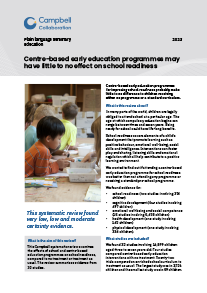
- See the full review https://onlinelibrary.wiley.com/doi/full/10.1002/cl2.1363
-
English
PLAIN LANGUAGE SUMMARY
Centre-based early education programmes may have little to no effect on school readiness
Centre-based early education programmes for improving school readiness probably make little to no difference to children receiving either no programme or a standard curriculum.
What is this review about?
In many parts of the world, children are legally obliged to attend school at a particular age. The age at which compulsory education begins can range between three and seven years. Being ready for school could have life-long benefits.
School readiness covers elements of a child’s development that promote learning such as positive behaviour, emotional well-being, social skills and intelligence.
Interventions can foster play and sharing, listening skills and emotional regulation which all help contribute to a positive learning environment.
We wanted to find out if attending a centre-based early education programme for school readiness was better than not attending any programme or receiving a standard pre-school programme.
We found evidence for:
- school readiness (two studies involving 374 children)
- cognitive development (four studies involving 497 children)
- emotional well-being and social competence (15 studies involving 5,438 children)
- health development (one study involving 142 children)
- physical development (one study involving 334 children).
What is the aim of this review?
This Campbell systematic review examines the effects of school and centre-based education programmes on school readiness, compared to no treatment or treatment as usual. The review summarizes evidence from 32 studies.
What studies are included?
We found 32 studies involving 16,899 children aged three to seven years old. Four studies compared centre-based early education interventions with no treatment. Twenty-two trials compared an enriched school curriculum to treatment as usual. The largest study was in 3,726 children and the smallest study was in 59 children.
Studies were conducted around the world, mostly in the USA (28 studies).
Studies, on average, lasted for 12 months; the longest trial lasted six years. The US federal government funded most studies.
What are the main findings of this review?
Centre-based interventions may have little to no effect on school readiness but we are very uncertain about the results. We have very low, low and moderate confidence in the evidence for a number of reasons:
- It is possible that people in the studies were aware of which treatment they were getting.
- The studies used different ways of delivering the intervention.
- Not all of the studies provided data about everything that we were interested in. The evidence focused on specific academic outcomes whereas the question we wanted to answer was broader, and
- There are not enough studies to be certain about the results of our outcomes.
What do the findings of the review mean?
Future studies should consider how best to measure school readiness, and over a longer timeframe. There should be more studies conducted in countries other than the USA.
How up-to-date is this review?
The review authors searched for studies up to October 2021.
The Campbell Collaboration is an international non-profit research network. We summarise and evaluate the quality of evidence about programmes in the social and behavioural sciences. Our aim is to help people make better choices and better policy decisions.
Additional Info
- Authors Anja Bondebjerg, Trine Filges, Jan Hyld Pejtersen, Malene Wallach Kildemoes, Hermann Burr, Peter Hasle, Emile Tompa, Elizabeth Bengtsen
- Published date 2023-12-11
- Coordinating group(s) Social Welfare
- Type of document Plain language summary Evidence and gap map
- Title Occupational health and safety regulatory interventions to improve the work environment: An evidence and gap map
-
Library Image
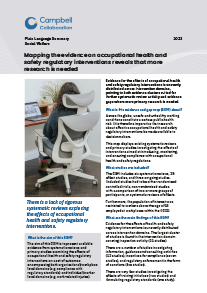
- See the full review https://onlinelibrary.wiley.com/doi/10.1002/cl2.1371
-
English
PLAIN LANGUAGE SUMMARY
Mapping the evidence on occupational health and safety regulatory interventions reveals that more research is needed
Evidence for the effects of occupational health and safety regulatory interventions is unevenly distributed across intervention domains, pointing to both evidence clusters suited for further systematic review activity and evidence gaps where more primary research is needed.
What is this evidence and gap map (EGM) about?
Across the globe, unsafe and unhealthy working conditions constitute a serious public health risk. It is therefore imperative that research about effective occupational health and safety regulatory interventions be made available to decisionmakers.
This map displays existing systematic reviews and primary studies investigating the effects of interventions aimed at introducing, monitoring, and ensuring compliance with occupational health and safety regulations.
What is the aim of this EGM?
The aim of this EGM is to present available evidence from systematic reviews and primary studies examining the effects of occupational health and safety regulatory interventions on a set of outcomes encompassing both organisational/workplace level domains (e.g. compliance with regulatory standards) and individual/worker level domains (e.g. work-related injuries).
What studies are included?
The EGM includes six systematic reviews, 28 effect studies, and three on-going studies. Included studies had to be either randomised controlled trials, non-randomised studies with a comparison of two or more groups of participants, or systematic reviews of effects.
Furthermore, the population of interest was restricted to workers above the age of 15 employed at workplaces within the OECD.
What are the main findings of this EGM?
Evidence for the effects of health and safety regulatory interventions is unevenly distributed across intervention domains. The largest cluster of studies is found in the intervention domain covering inspection activity (21 studies).
There are a number of studies investigating information, guidance and consulting activities (12 studies), incentives for compliance (seven studies), and regulatory enforcement in the form of sanctions (five studies).
There are very few studies investigating the effects of training initiatives (two studies) and formulating regulatory standards (one study).
Included systematic reviews were critically appraised. This appraisal led to the conclusion that there is a lack of rigorously-performed systematic reviews exploring the effects of occupational health and safety regulatory interventions.
In terms of the geographical spread of studies across the OECD area, North America (USA and Canada) is the most densely populated, followed by Europe (represented by countries located in both the Northern and Southern parts of the continent), and finally Eastern Asia (represented by South Korea).
What do the findings of this EGM mean?
This EGM provides an opportunity for stakeholders from the research, policy and practice communities to gain an overview of the available evidence on the effects of occupational health and safety regulatory interventions.
By pointing to both evidence clusters and gaps in the current evidence base, the EGM can inspire future research projects and intervention activities.
How up-to-date is this EGM?
The authors carried out literature searches up to January 2023.
The Campbell Collaboration is an international, voluntary, non-profit research network. We summarise and evaluate the quality of evidence about programmes in the social and behavioural sciences. Our aim is to help people make better choices and better policy decisions.
Additional Info
- Authors Denise Rousseau, Byeong Jo Kim, Ryan Splenda, Sarah Young, Jangbum Lee, Donna Beck
- Published date 2023-12-11
- Coordinating group(s) Business and Management
- Type of document Review Plain language summary
- Title Does chief executive compensation predict financial performance or inaccurate financial reporting in listed companies?
-
Library Image
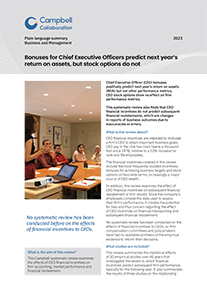
- See the full review https://onlinelibrary.wiley.com/doi/10.1002/cl2.1370
-
English
PLAIN LANGUAGE SUMMARY
Bonuses for Chief Executive Officers predict next year’s return on assets, but stock options do not
Chief Executive Officer (CEO) bonuses positively predict next year’s return on assets (ROA) but not other performance metrics. CEO stock options show no effect on firm performance metrics.
This systematic review also finds that CEO financial incentives do not predict subsequent financial restatements, which are changes in reports of business outcomes due to inaccuracies or errors.
What is this review about?
CEO financial incentives are intended to motivate a firm’s CEO to attain important business goals. CEO pay in the USA has risen nearly a thousand fold since 1978, relative to a 12% increase for rank and file employees.
The financial incentives covered in this review include the most frequently-studied incentives: bonuses for achieving business targets and stock options on favorable terms, increasingly a major source of CEO wealth.
In addition, this review examines the effect of CEO financial incentives on subsequent financial restatement of firm results. Since the company’s employees compile the data used to assess their firm’s performance, it creates the potential for bias and thus concern regarding the effect of CEO incentives on financial misreporting and subsequent financial restatement.
No systematic review has been conducted on the effects of financial incentives to CEOs, so firm compensation committees and policymakers have had no available synthesis of the empirical evidence to inform their decisions.
What is the aim of this review?
This Campbell systematic review examines the effects of CEO financial incentives on firm accounting, market performance and financial restatement.
What studies are included?
This review summarizes the statistical effects of 20 empirical studies over 40 years that investigated the extent to which financial incentives predict subsequent firm performance, typically for the following year. It also summarizes the results of three studies on the relationship between CEO financial incentives and subsequent financial restatement of business outcomes.
We include studies conducted between 1980 and 2023: the era of deregulation and increased competition begun under the administrations of Reagan in the USA and Thatcher in the UK.
Included studies are from publicly traded firms in which CEO financial incentives at one point in time were obtained retrospectively to investigate their predictive effects on subsequent outcomes.
Studies represent firms across the globe but mostly carried out in the USA, Europe and Australia.
Studies all had potential methodological weaknesses and typically failed to report their treatment of missing data. None used experimental designs. Included studies are those reported in English.
What are the main findings of this review?
CEO bonuses positively predict next year’s ROA but have no effect on either next year’s market-to-book value (Tobin’s Q) or stock return.
Stock options have no effect on next year’s ROA or any market-related metrics.
Too few studies exist to test other time lags or incentive effects on other outcomes. CEO financial incentives have no effect on financial restatement.
How up-to-date is this review?
The review authors searched for studies up to 2021 and then updated it through 2023 by searching the two most productive research databases.
The Campbell Collaboration is an international, voluntary, non-profit research network. We summarise and evaluate the quality of evidence about programmes in the social and behavioural sciences. Our aim is to help people make better choices and better policy decisions.
Additional Info
- Authors Jorien Laermans, Hans Scheers, Philippe Vandekerckhove, Emmy De Buck
- Published date 2023-12-04
- Coordinating group(s) Methods
- Type of document Review Plain language summary
- Title Friendly visiting by a volunteer for reducing loneliness or social isolation in older adults
-
Library Image
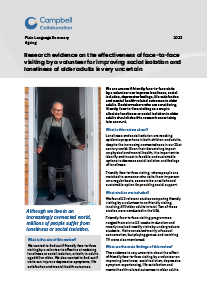
- See the full review https://doi.org/10.1002/cl2.1359
-
English
PLAIN LANGUAGE SUMMARY
Research evidence on the effectiveness of face-to-face visiting by a volunteer for improving social isolation and loneliness of older adults is very uncertain
We are unsure if friendly face-to-face visits by a volunteer can improve loneliness, social isolation, depressive feelings, life satisfaction and mental health-related outcomes in older adults. Decisionmakers who are considering friendly face-to-face visiting as a way to alleviate loneliness or social isolation in older adults should take this research uncertainty into account.
What is this review about?
Loneliness and social isolation are reaching epidemic proportions in both children and adults, despite the increasing connectedness in our 21st century world. Given their devastating impact on physical and mental health, it is important to identify and invest in feasible and sustainable options to decrease social isolation and feelings of loneliness.
Friendly face-to-face visiting, where people are matched to someone who visits them in-person on a regular basis, seems to be a realistic and sustainable option for providing social support.
What is the aim of this review?
We wanted to find out if friendly face-to-face visiting by a volunteer is effective at reducing loneliness or social isolation, or both, in adults aged 60 or older. We also wanted to find out if visits can improve depressive symptoms, life satisfaction and mental health outcomes.
What studies are included?
We found 13 relevant studies comparing friendly visiting by a volunteer to no friendly visiting, involving 470 older adults in total. Ten of these studies were conducted in the USA.
Friendly face-to-face visiting programmes ranged from six to 12 weeks in duration and mostly involved weekly visits by undergraduate students. Visits consisted mainly of casual conversation, but playing games and watching TV were also mentioned.
What are the main findings of this review?
The evidence is very uncertain about the effect of friendly face-to-face visiting by a volunteer on improving loneliness, social isolation, depressive symptom experiencing, life satisfaction and mental health-related outcomes in older adults.
None of the studies reported on the long-term effects (more than six months after the friendly visiting programme has ended) on loneliness or social isolation. None of the studies reported on the medium-term effects (1-6 months after the programme has ended) on mental health.
What do the findings of this review mean?
We have very little confidence in the evidence, because the studies were very small, used methods likely to lead to errors in their results, and often did not transparently report all data. Given the limitations of the available evidence, further research is very likely to change the results of our review.
How up-to-date is this review?
The authors searched for studies up to August 2021.
The Campbell Collaboration is an international, voluntary, non-profit research network. We summarise and evaluate the quality of evidence about programmes in the social and behavioural sciences. Our aim is to help people make better choices and better policy decisions.
Additional Info
- Authors Omar Dewidar, Jessica John, Aqeel Baqar, Mohamad Tarek Madani, Ammar Saad, Alison Riddle, Erika Ota, Jacqueline K. Kung'u, Mandana Arabi, Manoj Kumar Raut, Seth S. Klobodu, Sarah Rowe, Jennifer Hatchard, Jennifer Busch-Hallen, Chowdhury Jalal, Sara Wuehler, Vivian Welch
- Published date 2023-11-29
- Coordinating group(s) International Development
- Type of document Review Plain language summary
- Title Effectiveness of nutrition counseling for pregnant women in low- and middle-income countries to improve maternal and infant behavioral, nutritional, and health outcomes
-
Library Image
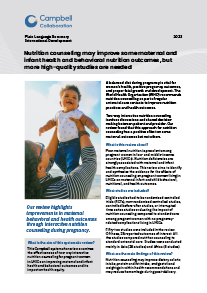
- See the full review https://onlinelibrary.wiley.com/doi/10.1002/cl2.1361
-
English
PLAIN LANGUAGE SUMMARY
Nutrition counseling may improve some maternal and infant health and behavioral nutrition outcomes, but more high-quality studies are needed
A balanced diet during pregnancy is vital for women’s health, positive pregnancy outcomes, and proper fetal growth and development. The World Health Organization (WHO) recommends nutrition counselling as part of regular antenatal care contacts to improve nutrition practices and health outcomes.
Two-way interactive nutrition counseling involves discussions and shared decision-making between patient and provider. Our review found that this approach for nutrition counseling has a positive effect on some maternal outcomes but not others.
What is this review about?
Poor maternal nutrition is prevalent among pregnant women in low- and middle-income countries (LMICs). Nutrition deficiencies are strongly associated with maternal and infant health complications. This review aims to identify and synthesize the evidence for the effects of nutrition counseling on pregnant women living in LMICs on maternal infant and child behavioral, nutritional, and health outcomes.
What is the aim of this systematic review?
This Campbell systematic review examines the effectiveness of two-way interactive nutrition counseling for pregnant women in LMICs on improving maternal and infant health and behavioral outcomes and its impact on health equity.
What studies are included?
Eligible studies had to be randomized controlled trials (RCTs), non-randomized controlled studies, controlled before-after studies, or interrupted time series studies evaluating the impact of nutrition counseling compared to standard care among pregnant women with no pregnancy-related complications living in LMICs.
Fifty-two studies were included in the review. Of these, 28 reported outcomes of interest. All the studies compared nutrition counseling to standard antenatal care. Studies were conducted mainly in Asia (28 studies) and Africa (8 studies).
What are the main findings of this review?
Nutrition counseling may improve dietary caloric intake, protein and fat intake, and gestational weight gain within health recommendations and may reduce hemorrhage during post-delivery.
Little to no effect was found in reducing the risk of cesarian delivery or improving hemoglobin concentration.
Nutrition counseling shows little to no difference in reducing the rate of stillbirths and anemia.
No studies reported the effects of nutrition counseling on maternal mortality, iron deficiency, or assessed iron intake.
What do the findings of this review mean?
Our review highlights improvements in maternal behavioral and health outcomes through interactive nutrition counseling during pregnancy. However, inconsistencies in the definition of nutrition counseling studies conducted in LMICs and low certainty of evidence limit our interpretation of the findings. Thus, high-quality studies with a standardized definition of nutrition counseling that highlights the interactive nature of the practice and a clear theory of change for maternal and infant behavioral and health outcomes are needed.
Findings for impact on health equity were scarce and uncertain.
How up-to-date is this Campbell review?
The review authors searched for studies up to June 2021.
The Campbell Collaboration is an international, voluntary, non-profit research network. We summarise and evaluate the quality of evidence about programmes in the social and behavioural sciences. Our aim is to help people make better choices and better policy decisions.
Additional Info
- Authors Vivian Welch, Elizabeth T. Ghogomu, Victoria I. Barbeau, Sierra Dowling, Rebecca Doyle, Ella Beveridge, Elisabeth Boulton, Payaam Desai, Jimmy Huang, Nour Elmestekawy, Tarannum Hussain, Arpana Wadhwani, Sabrina Boutin, Niobe Haitas, Dylan Kneale, Douglas M. Salzwedel, Roger Simard, Paul Hébert, Christopher Mikton
- Published date 2023-11-27
- Coordinating group(s) Ageing
- Type of document Plain language summary Evidence and gap map
- Title Digital interventions to reduce social isolation and loneliness in older adults: An evidence and gap map
-
Library Image
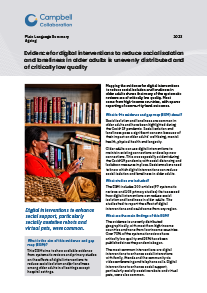
- See the full review https://onlinelibrary.wiley.com/doi/10.1002/cl2.1369
-
English
PLAIN LANGUAGE SUMMARY
Evidence for digital interventions to reduce social isolation and loneliness in older adults is unevenly distributed and of critically low quality
Mapping the evidence for digital interventions to reduce social isolation and loneliness in older adults shows that many of the systematic reviews are of critically low quality. Most come from high-income countries, with sparse reporting of community-level outcomes.
What is this evidence and gap map (EGM) about?
Social isolation and loneliness are common in older adults and have been highlighted during the Covid-19 pandemic. Social isolation and loneliness pose a significant concern because of their impact on older adults’ well-being, mental health, physical health and longevity.
Older adults can use digital interventions to maintain existing connections or develop new connections. This was especially evident during the Covid-19 pandemic, with social distancing and lockdown measures in place. Decisionmakers need to know which digital interventions can reduce social isolation and loneliness in older adults.
The interactive EGM can be accessed here: https://onlinelibrary.wiley.com/pb-assets/assets/18911803/Campbell%20map-Oct5_WITH-1697552065.html
What is the aim of this evidence and gap map (EGM)?
This EGM aims to show available evidence from systematic reviews and primary studies on the effects of digital interventions to reduce social isolation and/or loneliness among older adults in all settings except hospital settings.
What studies are included?
The EGM includes 200 articles (97 systematic reviews and 103 primary studies) that assessed how digital interventions can reduce social isolation and loneliness in older adults. The studies had to report the effect of digital interventions and could come from any region.
What are the main findings of this EGM?
The evidence is unevenly distributed geographically, with most from high-income countries and none from low-income countries. Over 70% of the systematic reviews have critically low quality and 25% have been published since the pandemic began.
The most common interventions are digital interventions to enhance social interactions with family, friends and the community via videoconferencing and telephone calls. Digital interventions to enhance social support, particularly socially assistive robots and virtual pets, were also common.
Most interventions focus on reducing loneliness and depression and improving quality of life of older adults.
Community level outcomes and process indicators are hardly reported, and no included studies or reviews assess affordability or lack of accessibility, although the value of accessibility and barriers caused by lack of accessibility were discussed in three studies and three reviews. Adverse effects are reported in very few studies and reviews.
Participants from the LGBTQIA2S+ community are not included in any study or review and only one study restricted participants to 80 years and older. Very few studies or reviews describe how at-risk populations were recruited or conduct any equity analysis to assess differential effects for populations experiencing inequities across PROGRESS-Plus factors.
What do the findings of this EGM mean?
This map is the first step towards identifying which digital interventions are effective for reducing social isolation and loneliness in older adults. The EGM contributes to the longer-term aim of building an evidence architecture for the field, whereby the use of evidence becomes institutionalised in policy and practice.
Although the evidence is relatively large and recent, it is unevenly distributed and there is need for more high-quality research. This map can guide researchers and funders to consider areas of major gaps as priorities for further research.
How up-to-date is this EGM?
The authors searched for studies published up to May 2021.
The Campbell Collaboration is an international, voluntary, non-profit research network that publishes evidence syntheses. We summarise and evaluate the quality of evidence about programmes in the social and behavioural sciences. Our aim is to help people make better choices and better policy decisions.
Additional Info
- Authors Enrica Donolato, Enrico Toffalini, Kristin Rogde, Anders Nordahl-Hansen, Arne Lervåg, Courtenay Norbury, Monica Melby-Lervåg
- Published date 2023-11-27
- Coordinating group(s) Disability
- Type of document Review Plain language summary
- Title Oral language interventions can improve language outcomes in children with neurodevelopmental disorders
-
Library Image
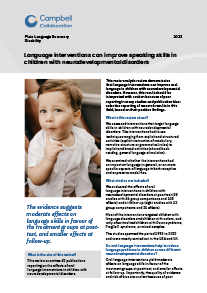
- See the full review https://onlinelibrary.wiley.com/doi/full/10.1002/cl2.1368
-
English
PLAIN LANGUAGE SUMMARY
Language interventions can improve speaking skills in children with neurodevelopmental disorders
This meta-analytic review demonstrates that language interventions can improve oral language in children with neurodevelopmental disorders. However, this result should be interpreted with caution because of poor reporting in many studies and publication bias: selective reporting of research results in this field, based on their positive findings.
What is this review about?
We assessed interventions that target language skills in children with neurodevelopmental disorders. The interventions had to use techniques ranging from explicit and structured activities (explicit instruction of vocabulary, narrative structure or grammatical rules) to implicit and broad activities (shared book reading, general language stimulation).
We examined whether the interventions had an impact on language in general, or on more specific aspects of language in both receptive and expressive modalities.
What is the aim of this review?
This review examines 42 publications reporting on the effects of oral language interventions in children with neurodevelopmental disorders.
What studies are included?
We evaluated the effects of oral language interventions in children with neurodevelopmental disorders at post-test (38 studies with 46 group comparisons and 108 effects) and at follow-up (eight studies with 12 group comparisons and 21 effects).
Most of the interventions targeted children with language disorders and children with autism, and only a few involved children with Down syndrome, Fragile X syndrome, or mixed samples.
The studies spanned the period 1993 to 2022 and were mostly carried out in the USA and UK.
Do oral language interventions help to reduce language problems in children across different neurodevelopmental disorders?
Oral language interventions yield moderate effects on language skills in favour of the treatment groups at post-test, and smaller effects at follow-up. Importantly, the quality of evidence and risk of bias are unclear because of poor reporting of critical aspects of the study design, such as recruitment and randomisation.
Overall, the analyses indicate potential publication bias, with small positive studies tending to yield larger treatment effects.
What factors affect how well oral language interventions work?
From pre- to post-test, participants’ characteristics and treatment components and implementation of the language interventions were not significant moderators. (Participants’ characteristics refers to children’s diagnosis, diagnostic status, age, sex, and non-verbal cognitive ability and severity of language impairment. Treatment components and implementation refers to intervention content, setting, delivery agent, session structure of the intervention or total number of sessions.)
However, smaller effects emerged for receptive vocabulary and multi-component receptive measures compared to expressive vocabulary, grammar, expressive and receptive discourse, and multi-component expressive tests.
Longer sessions conducted over a longer period were more beneficial than brief sessions and short-term interventions.
What do the findings of the review mean?
The current evidence base is promising but inconclusive. To drive evidence-based practice and policy, we need pre-registration and replication of more robust and adequately powered trials. Studies should include a wider range of diagnostic conditions. Further research should also report on long-term follow-up.
How up-to-date is this review?
The review authors searched for studies up to April 2022.
The Campbell Collaboration is an international, voluntary, non-profit research network that publishes evidence syntheses. We summarise and evaluate the quality of evidence about programmes in the social and behavioural sciences. Our aim is to help people make better choices and better policy decisions.
Additional Info
- Authors Michelle Sydes, Lorelei Hine, Angela Higginson, James McEwan, Laura Dugan, Lorraine Mazerolle
- Published date 2023-11-14
- Coordinating group(s) Crime and Justice
- Type of document Plain language summary Evidence and gap map
- Title Criminal justice interventions for preventing radicalisation, violent extremism and terrorism: An evidence and gap map
-
Library Image
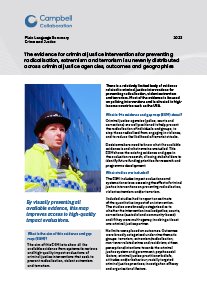
- See the full review https://onlinelibrary.wiley.com/doi/10.1002/cl2.1366
-
English
PLAIN LANGUAGE SUMMARY
The evidence for criminal justice interventions for preventing radicalisation, extremism and terrorism is unevenly distributed across criminal justice agencies, outcomes and geographies
There is a relatively limited body of evidence related to criminal justice interventions for preventing radicalisation, violent extremism and terrorism. Most of the evidence is focused on policing interventions and is situated in high-income countries such as the USA.
What is this evidence and gap map (EGM) about?
Criminal justice agencies (police, courts and corrections) are well positioned to help prevent the radicalisation of individuals and groups, to stop those radicalised from engaging in violence, and to reduce the likelihood of terrorist attacks.
Decisionmakers need to know what the available evidence is and what remains unstudied. This EGM shows the existing evidence and gaps in the evaluation research, allowing stakeholders to identify future funding priorities for research and programme development.
The interactive EGM is available here: https://onlinelibrary.wiley.com/pb-assets/assets/18911803/EGM%200059%20Sydes%20Map_Expanded_Standard-1695731881.html.
What is the aim of this EGM?
The aim of this EGM is to show all the available evidence from systematic reviews and high-quality impact evaluations of criminal justice interventions that seek to prevent radicalisation, violent extremism and terrorism.
What studies are included?
The EGM includes impact evaluations and systematic reviews assessing the effect of criminal justice interventions on preventing radicalisation, violent extremism and/or terrorism.
Included studies had to report an estimate of the quantitative impact of an intervention. The studies were broadly categorised as to whether the intervention involved police, courts, corrections (custodial and community-based) and if they were multi-agency, involving at least one criminal justice partner.
No limits were placed on outcomes. Outcomes were broadly categorised under nine thematic groups: terrorism; extremism/radicalisation; non-terror related crime and recidivism; citizen perceptions/intentions towards the criminal justice system and government; psychosocial factors; criminal justice practitioner beliefs, attitudes and/or behaviour; racially targeted criminal justice practices; investigation efficacy and organisational factors.
The map includes 70 studies from 71 documents: two systematic reviews and 68 impact evaluations. The included impact evaluations are predominantly quasi-experimental studies.
What are the main findings of this map?
The studies are unevenly distributed across criminal justice agencies. Policing is the most heavily populated area of the map, representing 58 of the 70 studies. There are relatively few studies that evaluate courts and prison interventions for preventing terrorism/radicalisation. No studies evaluate the impact of community corrections interventions.
The most common outcome measures are related to terrorism (n=20), including terrorism incidents (n=14), fatalities caused by terrorism (n=4), citizen willingness to report terrorism (n=2) and diffusion/displacement effects (n=1).
Investigation efficacy (for example detection of guilt, detection of suspicious activities, and information sharing) and organisational factors (such as inter-agency collaboration and uptake of Homeland Security initiatives) are also frequently evaluated. However, very few studies evaluate intervention impact using measures of radicalisation/extremism.
The majority of studies included on the EGM are situated in the USA or other high-income countries.
What do the findings of the map mean?
This EGM aims to provide a comprehensive and systematic display of the existing evidence on criminal justice interventions which aim to prevent radicalisation, violent extremism and/or radicalisation. By locating and visually presenting all available evidence, the EGM improves access to high-quality impact evaluations.
We suggest future counter-terrorism research pay attention to building researcher-practitioner partnerships that focus on scientific quality, with a clear agenda to build a more robust evidence base.
How up-to-date is this EGM?
The search was carried out between June and August 2022. The authors searched for studies published up to December 2021.
The Campbell Collaboration is an international, voluntary, non-profit research network that publishes systematic reviews. We summarise and evaluate the quality of evidence about programmes in the social and behavioural sciences. Our aim is to help people make better choices and better policy decisions.
Additional Info
- Authors Benjamin W. Fisher, Anthony Petrosino, Hannah Persson, Sarah Guckenburg, Trevor Fronius, Ivan Benitez, Kevin Earl
- Published date 2023-11-08
- Coordinating group(s) Crime and Justice, Education
- Type of document Review Plain language summary
- Title School-based law enforcement strategies to reduce crime, increase perceptions of safety, and improve learning outcomes in primary and secondary schools
-
Library Image
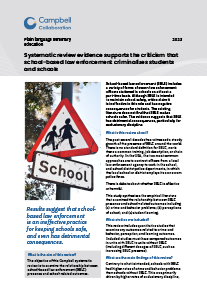
- See the full review https://onlinelibrary.wiley.com/doi/10.1002/cl2.1360
-
English
PLAIN LANGUAGE SUMMARY
Systematic review evidence supports the criticism that school-based law enforcement criminalizes students and schools
School-based law enforcement (SBLE) includes a variety of forms of sworn law enforcement officers stationed in schools on at least a part-time basis. Although SBLE is intended to maintain school safety, critics claim it is ineffective in this role and has negative consequences for students. The existing literature does not find that SBLE makes schools safer. The evidence suggests that SBLE has detrimental consequences, particularly for exclusionary discipline.
What is this review about?
The past several decades has witnessed a steady growth of the presence of SBLE around the world. There is no standard definition for SBLE, nor is there a common training, job description, or chain of authority. In the USA, the two most common approaches are to contract officers from a local law enforcement agency to work in the school, and school district police departments, in which the local school or district employs its own sworn police force.
There is debate about whether SBLE is effective or harmful.
This study synthesizes the empirical literature that examined the relationship between SBLE presence and school-related outcomes including (a) crime and behavior problems; (b) perceptions of school; and (c) student learning.
What is the aim of this review?
The objective of this Campbell systematic review is to examine the relationship between school-based law enforcement (SBLE) presence and school-related outcomes.
What studies are included?
This review includes quantitative studies that examine any outcomes related to crime and behavior, perception, and learning outcomes. Included studies must have compared outcomes in units with SBLE to units without SBLE (including different dosages of SBLE, such as increasing SBLE presence).
What are the main findings of this review?
Contrary to what is intended, schools with SBLE had higher rates of crime and behavior problems than schools without SBLE. This was primarily driven by higher rates of exclusionary discipline, with no detectable improvements to school crime or violence.
We also found that students in schools with SBLE tended to feel safer at school, although this finding is less trustworthy because it is based on very little data.
None of our other analyses showed that SBLE had beneficial effects.
These results suggest that SBLE is an ineffective practice for keeping schools safe, and even has detrimental consequences.
The findings are based on studies that vary in the extent to which we can infer causal relationships between SBLE and the outcomes of interest, so we urge caution in interpreting this as a cause-and-effect relationship. Still, the study’s findings are consistent across studies with different methodological characteristics.
What do the findings of the review mean?
These findings suggest that SBLE is not an effective strategy for maintaining school safety and lead to harm for students in the form of exclusionary discipline. However, limitations in the strength of the evidence affect the ability to claim that these relationships are causal.
How up-to-date is this review?
The final electronic search for the literature included in this review was carried out on 17 July 2020.
The Campbell Collaboration is an international, voluntary, non-profit research network that publishes systematic reviews. We summarise and evaluate the quality of evidence about programmes in the social and behavioural sciences. Our aim is to help people make better choices and better policy decisions.
Additional Info
- Authors Eric L. Sevigny, Jared Greathouse, Danye N. Medhin
- Published date 2023-10-30
- Coordinating group(s) Crime and Justice
- Type of document Review Plain language summary
- Title Health, safety, and socioeconomic impacts of cannabis liberalization laws: An evidence and gap map
-
Library Image

- See the full review https://onlinelibrary.wiley.com/doi/full/10.1002/cl2.1362
-
English
PLAIN LANGUAGE SUMMARY
The evidence on cannabis liberalization laws is unevenly distributed across policies and outcomes, and the research remains under-reviewed
An evidence and gap map (EGM) provides a systematic and visual representation of available research on a specific issue or topic. This EGM presents evidence on the effects of cannabis policies. The map reveals areas of both evidence concentration, which can aid systematic review and policy decisions, and evidence gaps, which can inform research and funding priorities.
Studies examining the effects of medical and recreational cannabis laws on cannabis use are relatively common. The evidence base for other laws and outcomes remains underdeveloped.
The interactive EGM is available here: https://onlinelibrary.wiley.com/pb-assets/assets/18911803/Cannabis_Liberalization_Laws_EGM_7-21-22_offline-1694705147.html
What is this EGM about?
The map provides descriptive and interactive displays of empirical evidence on the effects of cannabis liberalization laws. Specific interventions include laws that create or expand access to cannabis by removing criminal penalties, allowing medical use, or legalizing use for adults. Main outcomes include health, safety, and socioeconomic factors that are potentially linked to cannabis liberalization.
What is the aim of this evidence and gap map (EGM)?
The aim of this EGM is to present evidence on the effects of cannabis liberalization laws, including laws that create or expand access to cannabis by removing criminal penalties, allowing medical use, or legalizing use for adults.
What studies are included?
The EGM includes 447 studies, comprising 438 primary studies and nine systematic reviews. Eligible studies included works published in English since 1970 that employed quasi-experimental designs.
What are the main findings of this map?
Most cannabis liberalization research focuses on the effects of medical cannabis laws and recreational cannabis laws. These studies primarily investigate overall effects, but a sizable number also explore the specific effects of cannabis dispensaries.
Studies targeting other relevant laws—including medical cannabidiol laws, industrial hemp laws, and cultivation decriminalization laws—are relatively rare.
The map documented 113 distinct outcomes, with cannabis use outcomes investigated most frequently.
Although no geographic restrictions were applied, most of the evidence is from North America, predominantly the USA.
The systematic evidence base is relatively small, comprising just seven completed reviews on cannabis use, opioid-related harms, and alcohol-related outcomes. Five reviews were assessed as minimal quality and two as low quality.
How up-to-date is this EGM?
The literature search is current through 15 August 2020, with final study additions from other sources occurring on 12 November 2020.
Campbell is an international, voluntary, non-profit research network that publishes systematic reviews. We summarise and evaluate the quality of evidence about programmes in the social and behavioural sciences. Our aim is to help people make better choices and better policy decisions.


